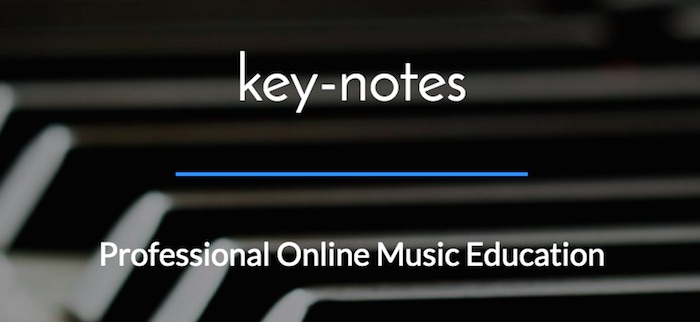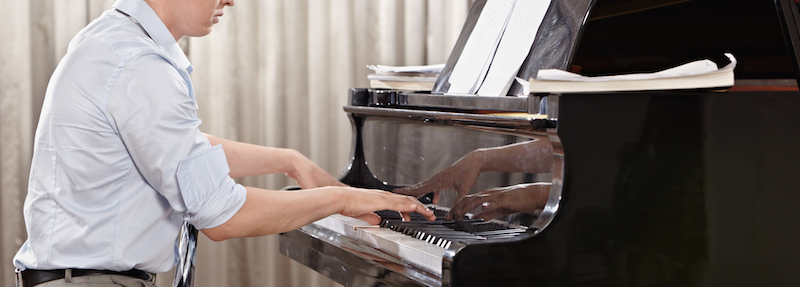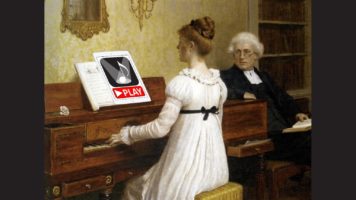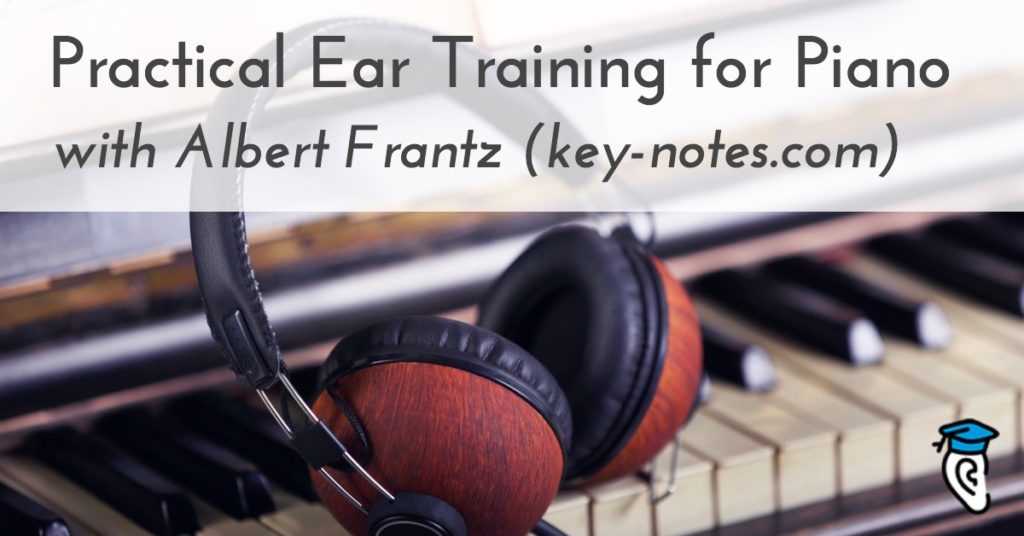If you want to learn piano online there are a variety of sites which promise to help, and it can be hard to determine which might be best for you. Here at Easy Ear Training we have long been impressed with key-notes.com due to its personal approach and healthy regard for the importance of ear training alongside instrumental technique.
The key-notes site was created by concert pianist Albert Frantz, who as well as running this successful site is also an IRONMAN athlete and a delegate to the United Nations, so we were excited and honoured that he took the time to join us for an interview today.
 We’ve previously featured Albert’s great resources on pitch ear training and learning solfège, and his range of ear training articles and we were delighted to have this opportunity to ask him about how key-notes incorporates ear training, whether piano is a suitable instrument for beginner musicians, and how to correctly approach specific aspects of piano technique.
We’ve previously featured Albert’s great resources on pitch ear training and learning solfège, and his range of ear training articles and we were delighted to have this opportunity to ask him about how key-notes incorporates ear training, whether piano is a suitable instrument for beginner musicians, and how to correctly approach specific aspects of piano technique.
Hi Albert, welcome to EasyEarTraining.com and thanks for joining us today!
Q: Here at Easy Ear Training we’re big believers that to become a confident and capable musician you need to learn ear training and music theory as well as instrument technique.
One notable part of the key-notes website is that you seem to take a similar approach, covering ear training right alongside piano technique and music theory.
Could you tell us why you place emphasis on ear training when many traditional piano teachers leave it aside?
 Music is fundamentally about sound, so we need to train our ears to become sensitive to sound in every way possible. On the one hand this means making sure the sounds we produce are the sounds we think we’re producing—in my experience one of the hardest tasks of music training—but it also means understanding the music we’re hearing. If we’re playing music, a trained ear helps to tell us which notes to play, secure our memory and lends us more confidence.
Music is fundamentally about sound, so we need to train our ears to become sensitive to sound in every way possible. On the one hand this means making sure the sounds we produce are the sounds we think we’re producing—in my experience one of the hardest tasks of music training—but it also means understanding the music we’re hearing. If we’re playing music, a trained ear helps to tell us which notes to play, secure our memory and lends us more confidence.
If we’re listening to music, it helps us to follow the harmony and form. Everyone who grows up listening to music in our culture has some sense of the tonic, the main note, in a conventional song we hear, such as a nursery rhyme. If you sing the first seven notes of a scale, even people without any musical training recognize that the leading tone needs to resolve to the tonic, even if they’ve never heard of these terms. It’s the same with the tonic triad. What I refer to as “listening comprehension” in music simply involves expanding the range of harmonies we recognize.
Too many pianists especially take a fundamentally mechanical approach to technique, relying on pressing the keys to tell them whether they played the correct notes. I think this is backwards. Ear training helps to guide our fingers to the correct notes because we develop certainty in advance of pressing the keys.
Of course there’s still a lot of “technical” work to be done with the fingers, but learning music with a strong foundation in aural skills is much deeper.
It’s not necessary to learn every possible chord, but I think music students should learn to recognize the most common chords and chord progressions as well as where a note is in the scale. Fortunately this is a highly trainable skill.
I recommend starting with learning to recognize scale degrees. I consider this much more important than learning to recognize “naked” intervals i.e. ones independent of a harmonic context. The reason is that almost all of the music we listen to and play has a harmonic context, meaning that it’s in a key. When we hear a melody, can we tell which note of the scale it starts and ends on for instance?
Students can start by singing the scale a song is in, then trying to determine which scale degrees are played. When doing so, it’s extremely important never to fumble around at the keyboard, striking keys more or less randomly until you find the one that matches the melody note. This is not playing by ear.
Rather, the correct steps are to figure out the scale of the song or piece, know the notes of the scale and maybe play them on your instrument, listen to the melody and determine the scale degrees played—and only then play the melody. This is true ear training!
 key-notes specializes in adult beginning to intermediate piano students. I learned piano as an adult myself and was fortunate to learn effective learning and teaching strategies for adult learners because I needed them myself. That said, we’ve been getting great feedback even from children who enjoy the lessons!
key-notes specializes in adult beginning to intermediate piano students. I learned piano as an adult myself and was fortunate to learn effective learning and teaching strategies for adult learners because I needed them myself. That said, we’ve been getting great feedback even from children who enjoy the lessons!
There’s also a very strong focus on music theory from lesson one. This way students really come to understand the pieces they play, which in turn allows them to express the music. They’re not just memorizing a sequence of keypresses.
I’ve been shocked to discover that many students entering a music conservatory tend to be lost when it comes to most music theory, even things that are quite basic such as period phrasing or cadences.
“We call it “[music] theory” but it’s really about drama, musical storytelling.”
We don’t need to overanalyze down to the n’th degree of detail, but we should have a basic understanding of what’s happening in each piece we play. We call it “theory” but it’s really about drama, musical storytelling. This is the vertical, horizontal, rhythmic and structural dissonance that makes music emotional.
This way we can recognize the most important dramatic events that happen in the music and emphasize them accordingly in our interpretation.
First, it’s important to point out the difference between reading music and sight reading, since the two are often conflated.
Reading music means understanding the symbols, recognizing the notes when you look at a page. Sight reading means being able to play a piece you’ve never heard or seen, directly from the notation, at first glance.
Students have problems when they try—or are expected—to sight read before they’ve mastered the fundamentals of reading music notation. Reading music is a prerequisite to sight reading, so teachers should really focus their efforts first on reading the music independently of playing an instrument.
The other thing to keep in mind is that the Western system of music notation is really as simple as it needs to be and as complex as it needs to be.
Students may see a complex score and assert that they “can’t read music.” Neither can I for the hard pieces I play! There will always be a differential between your playing level and your reading level. This is completely normal. That’s why we spend all those hours practicing.
I therefore don’t advise “alternative” methods to reading music, except to say that I strongly believe classical teachers need to emphasize aural skills from the beginning of studies as much as they do reading music. Trying to avoid reading notation is just delaying the inevitable.
As long as you break it down into its individual components, such as separating note recognition from rhythm, and reading one hand, staff or voice at a time, it can be accomplished step by step.

Q: It’s somewhat politically incorrect to suggest one instrument is more difficult than another but there are certainly reasons why piano might be considered especially challenging, due to the complexity of training and coordinating both hands, and reading two potentially independent harmonic parts in parallel.
Would you say this makes piano a difficult first instrument for the new musician? Does it have any particular impact on how effective internet-based training can be?
I think learning piano is like learning English: they say English is an easy language to learn poorly but incredibly difficult to master.
With the piano there’s the decisive advantage of being able to press a key and get the right note—there’s none of the years of training string players must undergo just to get the right pitch.
But the piano’s strength is also its weakness: Because the pitch is ready-made there’s nothing we can do to change it after the fact. If a note is out of tune, we have to live with it until we call the piano tuner. There are less expressive possibilities: no vibrato, no crescendo while holding a note.
But the piano does make up for these limitations in its flexibility, including the ability to play multiple voices. This definitely makes for challenges. It’s not just coordinating both hands that is a challenge, it’s listening to and shaping all the voices at once, as though each voice were played by a different melody instrument. We’re by no means limited to one voice per hand either.
This is another reason why ear training is so essential. I think the piano is really the ideal instrument for beginning musicians precisely because of these opportunities to comprehend music harmonically as well as melodically.
“I think the piano is really the ideal instrument for beginning musicians.”
As far as learning piano online goes, I see startups making the mistake of trying to reduce piano playing to mechanical keypresses. Most of them completely disregard all the actual skills that becoming a musician is really all about: ear training, sight reading, harmony, rhythm, formal analysis. I’d strongly advise prospective students not to fall for the marketing hype. If there’s no teaching, there’s no learning.
The most important is to learn to play blindfolded! Like ear training, this is also entirely trainable.
I used to be completely thrown off by different pianos in different settings, and I’m embarrassed to admit that I discovered I couldn’t even play all my scales without staring at the keyboard. At one point I actually had to retrain myself to play all scales without looking, and it was harder than I care to admit.
Now I’ve made a habit of trying to keep my eyes mostly off the keyboard and on the score whenever I learn a new piece especially. (When the hand position changes to a different register, then it’s okay to look before you leap.)
The other thing is to develop a piano technique that does not rely on touching the keys in advance of playing them. The fingers should not be resting on the keys before you play them, like almost all amateur pianists do. This may seem secure, but paradoxically it is a recipe for insecurity! Developing such a technique is only something working with an advanced professional teacher can help you achieve.
 Thanks so much! key-notes is a platform for learning piano online. The crowdfunding campaign allows us to produce more video lessons to continue to build the library to beyond the 200 very detailed lessons currently published. It also allows for software development.
Thanks so much! key-notes is a platform for learning piano online. The crowdfunding campaign allows us to produce more video lessons to continue to build the library to beyond the 200 very detailed lessons currently published. It also allows for software development.
Like you at Easy Ear Training, at key-notes we focus on using technology to develop human skill, not to replace it. This for me is the most important use of technology in education.
If Albert’s insights above gave you a new excitement for learning piano and developing your ears head on over to key-notes.com where you can learn more about Albert and the key-notes approach and explore free tutorials on ear training and other topics in the blog. We’re excited to watch the continuing success of key-notes!







